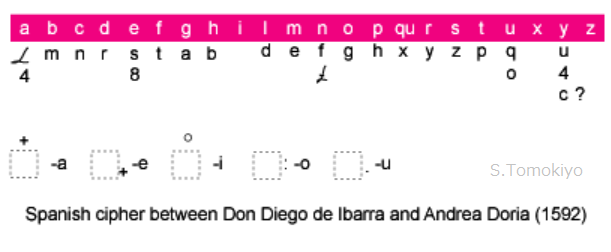
Of the variety of ciphers used during the reign of Philip II (see another article), use of vowel indicators is a hallmark of Spanish ciphers at the time. The present article presents its link to Milanese ciphers.
Vowel indicators as used herein are diacritic signs indicating vowels, which are combined with base symbols to systematically form syllables. They are used in many Spanish ciphers at the time (see another article) (though Kahn (1967) p.119 describes it as a "peculiarity" of a 1577 cipher). So, when I saw an undeciphered despatch in the French archives, I knew it was Spanish and, by luck, identified the right cipher (see another article).


However, vowel indicators was not an invention of the reign of Philip II: a similar cipher (called the Imperial Cipher of 1544-1554 for convenience) (see another article) was used as early as 1544. Prince Philip and Suarez de Figueroa used a similar cipher in 1543. Undated ciphers Cp.44 and Cp.45 with vowel indicators may also belong to the 1530s-1540s.

Earlier on, a Milanese cipher for use with Camillo Gilmo residing in the Imperial court (1530) (Meister (1902) p.32) employed a vowel indicator system.


From the above, it is tempting to say that the vowel indicator system was brought into Spanish secret writing from Milanese ciphers. But, of course, we need some evidence for a link between them.
A cipher between Lope de Soria and Antonio de Leyva (probably around 1528-1535, see anorhter article, called Leyva's Cipher (1528-1535) for convenience) looks like an incipient form of the vowel indicator system. (Of course, a consistent assignment of symbols to syllables in later ciphers is, though convenient for users, a weakness in terms of security.)
Antonio de Leyva was commander of the Imperial army in the Duchy of Milan. Considering that Lope de Soria used a cipher without vowel indicators in correspondence with the Emperor in 1523 (see anorhter article), it seems probable that the scheme was introduced by Antonio de Leyva, who might have either invented or learned it in Milan. However, considering that a letter of 1533 from Suarez de Figueroa to Leyva employed a different cipher, Leyva's Cipher (1528-1535) may have been introduced sometime between 1533 and 1535.
To establish the origin of the vowel indicator scheme, more specimens need to be found. In particular, a more accurate dating of Leyva's Cipher (1528-1535) is needed.
At least, use of diacritic signs to increase the number of symbols was known in Milan as early as around 1450, as shown by the following examples:
(i) a cipher between the Duchess of Milan (Bianca Maria Visconti? (Wikipedia; the last Visconti duke had died in 1447 but her husband was to become duke only in 1450)) and King Ferdinand (of Naples?), dated 14 March 1448 (Meister (1902) p.30)
(ii) a cipher ca. 1450, included in a codex, Franciscus Tranchedinus, Furtivae litterarum notae containing some 200 ciphers used by the Milanese Chancery (1450-1496) (Yale University)
(Section added in December 2018)
The cipher used by Genoese Admiral Andrea Doria in writing to Emperor Charles V from October 1528 (see another article) used a vowel indicator system.

This cipher (called herein the Doria-Charles V Cipher (1528)) employs mainly superscript numerals to indicate vowels. Although Leyva's Cipher (1528-1535) above also uses superscript numerals for some syllables, general impression is different and it does not seem one was modelled after the other.
After all, the vowel indicator system may have been devised in Milan and Genoa independently.
(Section added in January 2019)
Antonio de Leyva's letter of September 1527 employs a vowel indicator system. This is the earliest cipher with vowel indicators known to me.


(Section Added in June 2023)
An even earlier specimen was identified in letters deciphered by Marcello Simonetta and Norbert Biermann. It is the Castiglione-Schomberg Cipher used in March-April 1527 (see another article).
Castiglione was an apostolic nunctio (ambassador) sent by the Pope to Emperor Charles V in Spain. Schomberg worked for the Pope in negotiation with the Imperialists. If this cipher was provided by the Vatican, it is wondered how come the Holy See and the Imperialists introduced the same system about the same time. See the above-mentioned article for some discussion.

The vowel indicator scheme was also used in some other Italian ciphers other than Milanese:
(i) a cipher between Gio. Battista Ricasoli, Bishop of Cortona (1538-1560) and "mons. Giovanmatteo" (Meister (1906) p.210).
(ii) a cipher between Alfonso Rossetti, Bishop of Comacchio (1559-1563, thereafter Bishop of Ferrara) and the Duke of Ferrara (Meister (1906) p.312);
(iii) a cipher between Cardinal of Burgos and "il colonello N.M. di campo" (Meister (1906) p.217 identifies the cardinal with Francisco Pacheco, made cardinal in 1561 and made Bishop of Burgos in 1567 (Wikipedia) but, judging from the date 1557 of another cipher he used with Philip II, the "Cardinal of Burgos" may refer to Francisco de Mendoza and Bobadilla, made cardinal in 1544 and made Bishop of Burgos in 1550 (Wikipedia)).
Of these, the "Cardinal of Burgos" shared other ciphers with Philip II of Spain (Meister p.216, 217) and he may well have learned the scheme from the Spanish court. For the other two, although it is possible that these were devised independently, further search is desired to find links between these ciphers and Spanish or Milanese ciphers.
Aloys Meister (1902), Die Anfange der Modernen Diplomatischen Geheimschrift
Aloys Meister (1906), Die Geheimschrift im Dienste der Papstlichen Kurie
Related Articles:
S. Tomokiyo, Ciphers during the Reign of Emperor Charles V
S. Tomokiyo, Spanish Ciphers during the Reign of Philip II